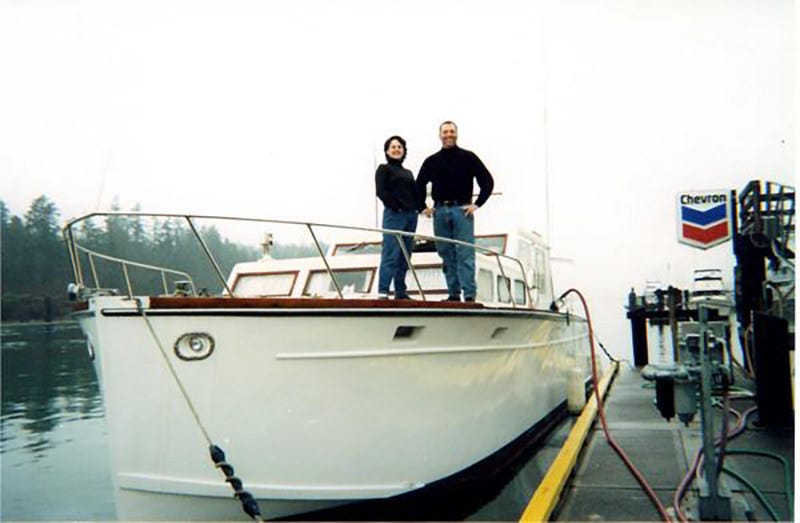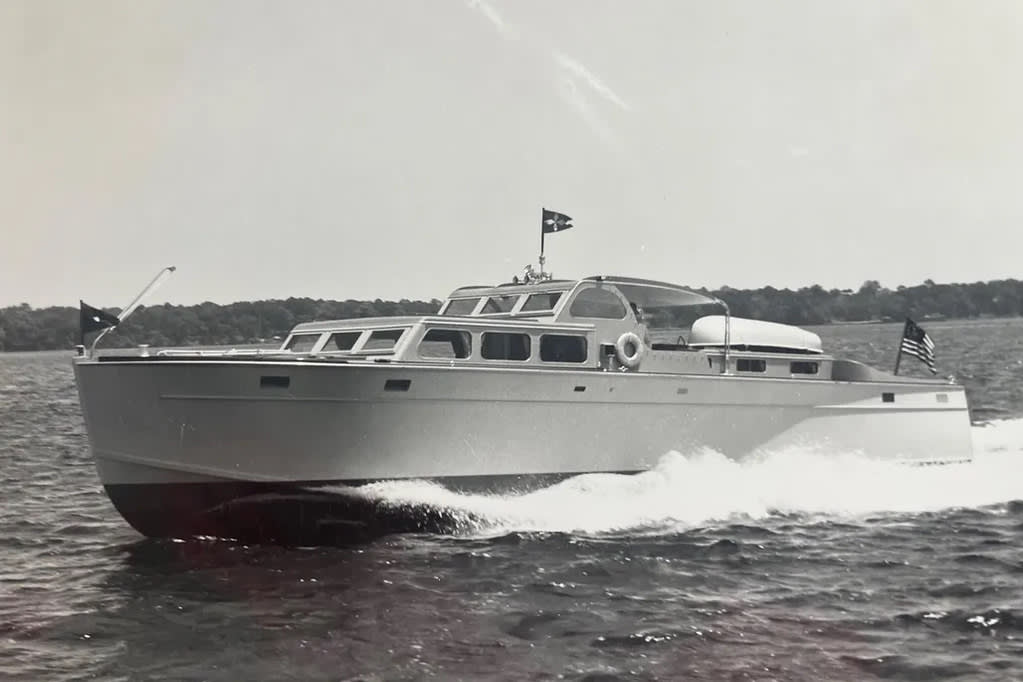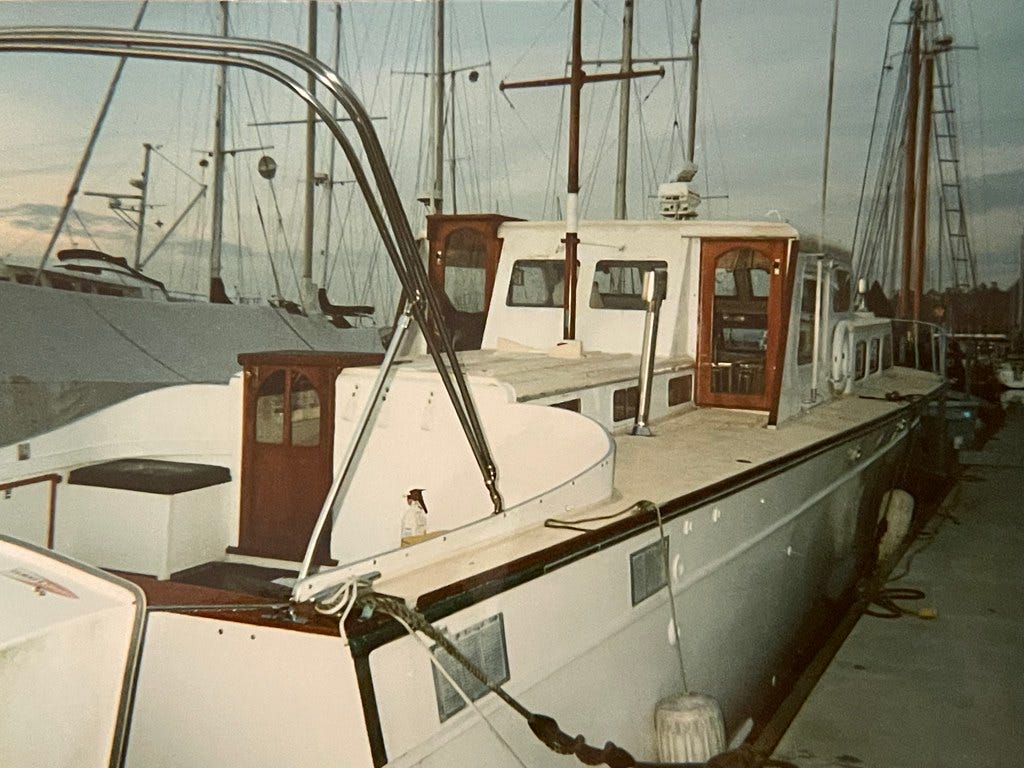Fueling Perihelion before leaving La Conner, with Victoria D. and John S. as crew
In 2000, after four years of living aboard my first boat, Savona, I decided that I wanted a different boat - something larger and faster, with style and presence. I had quit my job at the startup where I had worked for the previous decade, and taken a new job as a Technical Director for an international creative agency. I was in my early thirties, with all of the ambition that comes with that age. The world was mine to conquer, and I wanted a boat that fit my new bon vivant self image.
I knew of Huckins yachts, having lived on the next dock over from one for a few years as a boy, but it was a period photo of a Huckins Offshore 52 for sale that grabbed my attention when I started dreaming of another boat. Like Volvos, the Huckins Fairform Flyers look like “the box the boat came in”. They are big, fast and comfortable - built for a quick run to Cuba for a night of blackjack, cigars and mojitos. Papa Hemingway would definitely have approved.
I spent many hours over the next few months searching for the right boat. Even then, a classic Huckins was an expensive yacht, and I did not have the money for a restored example. So if I hoped to find one within my budget it would have to be a boat that needed work (although hopefully not too much work). There are not many Huckins on the West Coast, so I considered boats from all over the country, even making a trip to the Huckins yard in Jacksonville, Florida to look at a Neptune 45 - a slightly smaller boat than the Offshore 48 that I really wanted. But that boat was too much of a project. All the Huckins for sale were either fully restored and well out of my price range, or projects in need of complete restoration.
Eventually, I found an Offshore 48 for sale just a few miles away in La Conner Washington, but it was priced in the low six-figures, and out of reach. The price was not a lot for a nice classic Huckins, but this one had been modified with a faux-Victorian interior, including several thousand pounds of solid mahogany panelling and furniture straight out of a Sears catalog. The Huckins boats were designed to be light, stiff and fast. It would require a lot of work to bring that boat back to the shape that Frank Huckins had in mind when she was launched. But she was in the water and she was operational, so I kept watching the ads for the boat in La Conner as she sat, unsold, and the price steadily dropped.
After several decreases it finally reached what I thought was a reasonable level and I went for another look. The boat was just as bad as I had first thought, but the original Huckins design was still there, waiting to be resurrected from beneath the modifications. A survey indicated that the boat had no major structural problems, and a sea trial proved that she handled the way I had imagined she would, if a bit slower than designed with the added weight. I was able to sell Savona to a friend, clearing the last obstacle to buying her, and in December of 2000, I became the newest owner of Huckins Hull No. 175, a 1946 Offshore 48 originally named "Nirvana".
I brought the boat from La Conner to Shilshole Marina in Seattle on a mild, overcast, December day. That trip went well, but a few events foreshadowed the work to come. Both v-drives became very hot so we had to stop to prime the raw water pump. The port gear would not engage reliably, the center pilothouse window frame disintegrated and an electrical fault in the instrument panel threatened a fire until we shut down all non-essential systems. But in the excitement of finally taking the helm of my own Huckins those problems became trivial.
I renamed the boat Perihelion, meaning the point in the orbit of a planet closest to the sun. I thought of the new name as a symbol of the boat as a place in the sun where I could enjoy the life I was creating for myself, but I might have done better to think about that most famous of stories involving proximity to the sun, and the hubris of flying too high.
At this point, my intent was to live and cruise aboard Perihelion while slowly returning her to a more original state. I was most emphatically not going to do any of the following: Gut the interior, rebuild the engines, make major structural repairs, fiberglass the hull, re-cover the decks or conduct anything that could be called a "restoration".
The gods laugh at such resolutions.
While the pre-purchase survey on Perihelion did not find any serious structural issues there were a few recommendations that needed to be addressed immediately, including rot in the aft trunk cabin sides and adjacent deck and a couple of soft spots in the transom. So in January of 2001, a week after she first arrived in Seattle, I took Perihelion through the Ballard Locks to Lake Union for repairs. The trunk cabin rot eventually required replacement of both cabin sides and significant sections of the side deck. That work entailed a month-long stay in a shed while the repairs were completed. But once that that project was done I moved back to Shilshole Marina for what I fully expected would be a long spring and summer of cruising.
Perihelion at Shilshole Marina
Moving aboard Perihelion was the beginning of a story that spanned nearly fifteen years of my life - a period that brought a marriage, a house, and a child. It includes a lot of living, a couple of hospital visits, and one death. It is a story that ends badly, but not entirely without a little bit of grace, serendipity, and a chance for atonement.





I too envy your time on the water, Chris. Am I correct in assuming you plan to finish the sad story of flying too close to the sun?
Another story well told Chris... and you probably well realize that there is a book lurking among all these stories!? This tale feels like the opening chapter to a big long story. I can hardly wait to read the rest.
-Bruce